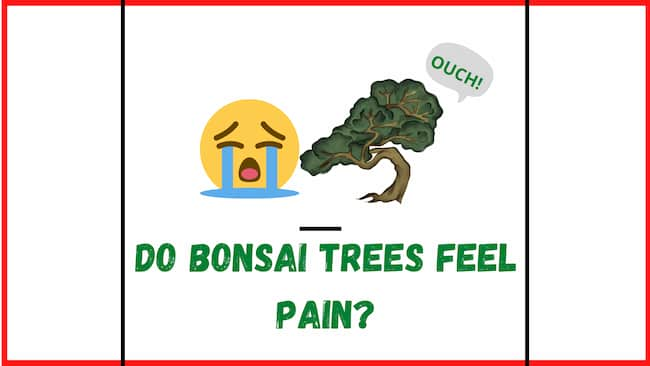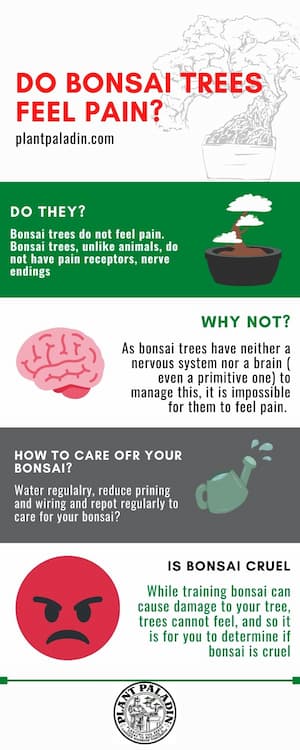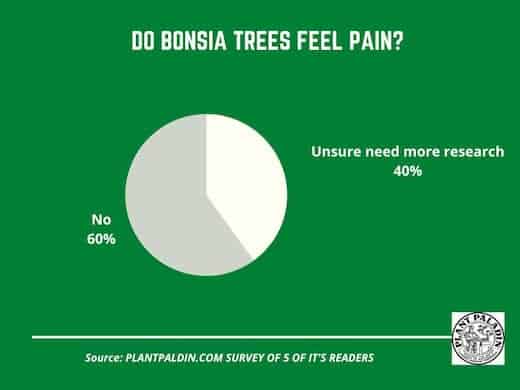This website is supported by its readers. If you click one of my links I may earn a commission. I am also a participant in the Amazon affiliates program and I will also earn a commission from qualified purchases.

So I’ve been training bonsai trees for about three years. While I still consider myself very much a beginner, one issue that I see popping up more is if transforming trees into bonsai is cruel and causes a bonsai to feel pain. So do bonsai trees feel pain?
Bonsai trees do not feel pain. Bonsai trees, unlike animals, do not have pain receptors, nerve endings, or brains and are physically incapable of feeling pain as humans do.
Some studies show that plants can feel and perceive movement, such as when an insect walks across one of its leaves, but the evidence is more sketchy when it comes to feeling pain.
So why exactly do bonsai trees not feel pain? Are there any tree species that do? Where did the myth of bonsai trees feeling pain originate? Keep reading to find out more!
Just a quick heads up, over the past three years of running Plantpaladin, hundreds of people have asked for product recommendations. As such, You can find my favorite indoor bonsai tree here (link takes you to Bonsaiboy), my favorite outdoor bonsai tree (link takes you to Bonsaiboy), or have a look at all the products I recommend here.
Do bonsai trees feel pain?
So having taken up bonsai as a hobby these past few years, I can see the arguments why some people consider bonsai to be cruel.
After all, getting the perfect size and style of bonsai requires a lot of pruning and wiring.
For example, let’s say you want a thicker, wider trunk for your tree to achieve something like a sumo bonsai style.
In effect, you will need to chop the tree’s trunk in half repeatedly for a few years or constrict the tree to force it to grow outwards.
While these different training methods can damage the tree if undertaken incorrectly, do they physically cause your bonsai tree to feel pain?
After all, the last thing we want to do is put sentient beings through pain if they don’t need to.
As such, a few months back, I got in touch with my local botanical garden, visited a few experts, read up on a few studies, and undertook my quick survey of 5 plant paladin readers to ask them do bonsai trees feel pain.
To summarize:
Do bonsai trees feel pain – quick facts
- Bonsai trees do not feel pain.
- The main reason is that bonsai tree species such as Elm, Oak, Ficus, or Juniper do not have pain receptors.
- Pain receptors are part of a nervous system that the brain activates when severe pressure is applied, causing pain.
- As bonsai trees have neither a nervous system nor a brain ( even a primitive pone) to manage this, it is impossible for them to feel pain.
- It is impossible for all flora, such as trees, shrubs, plants, and flowers, to feel pain.
- Training a bonsai, however, via general pruning, defoliating, or using deadwood techniques such as Jin or Sabaniki can damage the tree If undertaken incorrectly.
- Alternatively, not repotting your bonsai tree to the point where roots are constricted and impacting nutrient flow can also be problematic.

Let’s explore these points in more detail:
Why do bonsai trees not feel pain?
Now we know that bonsai trees don’t feel pain; why is this the case?
Well, put, to feel pain, you need four things:
- Sensory receptors
- Nerve fibers
- A brain stem
- A brain
How is pain typically felt?
In a breakthrough study almost 60 years old, Melzack and Wall came up with the Gate Control theory of pain, the benchmark theory of how pain is felt in living creatures.
To give you an example. Let’s say you were to stick your hand in a fire – pretty painful, right?!.
The theory determined that the following would happen:
- The sensory receptors in your skin would pick up the sensation in your skin.
- The nerve fibers in your arm would get the message and pass the message of pain into your brain stem.
- Your brain stem would then allocate how severe the pain is and how much pain you are feeling.
- Your brain stem would then pass the message on to the relevant part of your brain, giving you the feeling of pain.
All of which happen in lightning-fast time.
As in all plant life, bonsai does not have any of these elements (sensory receptors, nerve fibers, a brain stem, or a brain); they are physically incapable of feeling pain.
If bonsai do not have a brain, how do they function
So this is a question that has tested scientists and researchers for decades.
How do trees and plant life know how to do things such as absorb water from their roots, and stop growing at specific points in the year?
The current theory stems that some mechanism in the pants cells or biological structure allows trees to recall information.
For example, to absorb more water during the rainy season instead of doing so during the dry season.
This complex mechanism is typically formed by complex genes that can transform and react to their environments and adapt accordingly.
Studies on do bonsai trees feel pain
So I didn’t just want to go off my research but highlight what some experts say about bonsai trees and plants feeling pain.
As such, I’ve highlighted a few popular ones below that argue that plants do not feel pain:
Simcha Lev-Yadun – National Library Of Medicine
In an article first published in 2008 in plant signal behavior (Plant Signal Behav 2008; 3:612), Simcha Lev-Yadun argues that the argument that plants feel pain was absurd.
This was concerning the Swiss Executive Federal Council arguing that plant life and rights regarding pain needed to be protected.
Simcha Lev-Yadun then argued there was:
“No scientific argument in favor of plants feeling pain.”
Peta
In an article on their website – Peta argues that while plants can feel sensations, no one is sure if plants can feel pain.
Britania
A post on the Britannia website argued that while some studies have highlighted that mustard plants have detected electric stimulation on a cellular level, we should not anthropomorphize these as equivalent to pain.
Daniel Chamovitz – Vice news
Daniel Chamovitz, a dean of life sciences at Tel Aviv University, was interviewed by Vice news a few years back.
In his argument, he states that plants know in a general sense what is happening to them; for example, they know when a leaf is being cut by they do not have a screaming urge as in OMG, what is happening to be I’m feeling pain.
Professor Lincoln Taiz – 2009
In a 2009 article, professor Lincoln Taiz argues that plants do not have consciousness and react to external stimuli.
As such, they are not able to feel pain.
Do any studies prove bonsai feel pain?
So while the vast majority of scientific evidence point toward plants or bonsai not feeling pain, are there any that show the opposite?
A post from ESLAQ argues that plants use the same chemicals used for neural transmission as humans do to sense the outside world – mainly GABA (gamma-aminobutyric acid).
The post also argued that while it is easy to see human brains as they are easy to locate, plant brains are developed differently, growing through the root structure, and so are more complicated and more complex to study than human brains.
These complex structures, then, the writer argues, make it very difficult to argue that plants don’t feel pain.
Where did the argument about bonsai trees feeling pain come from?
The main arguments favoring bonsai trees’ pain originated from trees being visibly observed and studied to react to external stimuli.
While external stimuli such as rain or the sensation of a caterpillar walking on a tree are noticed by the tree, the argument that this is equivalent to pain has no factual scientific basis.
Other arguments have determined that trees have similar pain chemicals to humans when released, although this has not been peer-reviewed.
Do any species of bonsai feel pain?
No bonsai tree species feel pain. Like all plant life, Bonsai trees do not have the nervous system or brain to diagnose and react to pain.
This, too, applies to the fruit that some bonsai tree species produce.
For example, if a Squirrel eats the crabapple of a bonsai tree, it feels no pain.
How to be 100% sure you do not cause pain to your bonsai?
While the vast majority of scientific evidence proves that your bonsai trees do not feel pain if you want to be 100% sure and keep any perceived pain to a minimum in your bonsai, I would do the following:
- Consider planting your bonsai tree outdoors or regularly repot to prevent its roots from becoming stunned.
- Water, provide enough sunlight and keep at its correct temperature
- Give your tree ample time (up to two years) to recover from extensive training techniques such as wiring, trimming, or trunk development.
- Only train the bonsai when it is young and healthy and can recover from severe training techniques.
Survey on do bonsai trees feel pain
Finally, I got in and undertook my quick survey of plant paladin readers and asked them if they perceived transforming a tree into a bonsai to be painful for the tree.
Here are the results:

I also got in touch with an employee on a recent visit to my local botanical gardens and asked them if bonsai caused pain in the tree – here is what they said:
“There is no scientific evidence to show bonsai trees or plants in general feel pain like me or you.”
My top picks for the gear you will need!
So like I mentioned earlier, over the past three years of running PlantPaladin, hundreds of people have asked me for my recommendations on the best bonsai gear on the market.
Having spent thousands of dollars on bonsai items these past few years and tested at least 100 bonsai-specific products, I’ve listed my favorite products below – All of which I highly recommend and think you can get great value.
They can purchase directly by clicking the link to take them to Amazon.
Bonsai Tool Set: One of the significant challenges I’ve had is finding a toolset that was not only durable but didn’t break the bank. SOLIGT has recently developed a fantastic bonsai tool set that covers all the tools you need to trim, prune, and repot your trees. – You can grab it here.
Complete Bonsai Set: Many of you will want to grow your bonsai trees entirely from scratch, but finding the varicose seeds, pots, and other items in one place can be challenging. Leaves and Sole then have created a complete bonsai set that I’ve personally used that ticks all the boxes. You can grab it here.
Bonsai wire: The number of times I’ve run out of wire for my bonsai or purchased cheap bonsai wire that doesn’t do the job is embarrassing for me to admit. After a lot of trial and error, I found that using Hotop’s aluminum bonsai wire is one of the best options on the market. This can easily be used for both indoor and outdoor bonsai. You can grab it here.
This post was written by Fehed Nicass who has been passionate about bonsai for over 3 years. He currently resides in the UK and works in sales.
